Assaf Yasur-Landau
Haifa University
Eric H. Cline, The George Washington University
Co-Directors of the Kabri Archaeological Project
February 2009
Introduction
The Kabri Archaeological Project was initiated in 2005 under the direction of Assaf Yasur-Landau, now of Haifa University, and Eric H. Cline of The George Washington University. Four seasons of excavation, survey, and study have taken place so far, during the summers of 2005-2008, with funding and equipment generously provided by the Institute of Aegean Prehistory, the Institute of Archaeology at Tel Aviv University, UC Santa Cruz, and The George Washington University.
During the Middle Bronze Age, ca. 2000-1550 BCE, Tel Kabri was the center of a Canaanite polity located within what is now the western Galilee of Israel, five kilometers east of the Mediterranean Sea. Excavations conducted by Aharon Kempinski and Wolf-Dietrich Niemeier from 1986-1993 revealed the remains of domestic structures, a massive earthen rampart, and a large building identified by them as a palace on the basis of parallels with similar structures found at Alalakh in north Syria and elsewhere, all dating to the Middle Bronze (MB) period. They dated the palace to the MB II period and believed that it was preceded by the remains of an earlier MB I well-built structure, named by them the “proto-palace.”
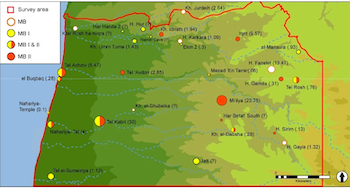
Map of MB I-II Sites
Within the palace were discovered Aegean-style floor and wall paintings, dating to the final part of the MB II period. Such evidence for artistic connections between the cultures of the ancient Aegean and Canaan is unique in Israel. It is also very rare elsewhere, existing outside the Aegean only in Egypt at Tel el-Dab’a, the capital city of the Hyksos, and at the sites of Alalakh and Qatna in Syria.
Initial magnetometer and conductivity surveys undertaken by Makovski and Yasur-Landau in 2003 indicated that as much as half of the MB II palace remains unexcavated. These circumstances create a very favorable situation where we have a possible Canaanite palace and proto-palace built directly on top of one another with no significant later remains above. This presents a rare opportunity, unique in Israel, to investigate two key sets of questions in the study of the Bronze Age world system in the eastern Mediterranean.
The first set of questions concerns the evolution of social complexity in the Middle Bronze Age and the role of exogenous versus endogenous factors in the rise of Canaanite rulership. Was the development of palatial culture a long and slow evolution extending through most of the MB I, or was it a rapid process, inspired by Syro-Mesopotamian traditions? Furthermore, a continuum of palatial structures standing one on top of the other would enable us to examine aspects of rulership that have not been previously investigated in the Middle Bronze Age southern Levant, such as the role of feasting and iconography in the negotiation and maintenance of political power, specifically at Tel Kabri.
A second set of questions relates to the nature of Aegean interactions with the site. The Kabri wall frescoes were shown by Niemeier to belong to the miniature style, with direct parallels to pre-eruption, LM IA Santorini. Thus, the absolute chronology of the Kabri frescoes may yield an important anchor connecting east and west, as well as possible insights on the absolute chronology of the Santorini eruption. At the same time, we wished to investigate the mechanism of cultural transmission between west and east which culminated in the Kabri frescoes. Was it a one-time event or was it the result of more prolonged contact with the Aegean world?
Regional Study
Our 2006 and 2007 regional study of the western part of the upper Galilee, the area of the kingdom of Kabri, yielded intriguing insights into the process of the rise and fall of this polity. During these seasons, the survey team visited 28 Middle Bronze Age sites in the area of Kabri and accurately recorded their size using GPS, following the boundaries of each site according to the surface distribution of MB II pottery. An analysis of unpublished pottery in the IAA storerooms, gathered by Dr. Rafi Frankel and others during four decades of visits to the sites, provided the settlement history of the region during the MB I, MB II, and the Late Bronze Age.
In the preliminary account of our findings, published in the Journal of Field Archaeology,1 we offered several initial observations on settlement patterns in the western Galilee during the MB period, including the following:
During the MB I period, the settlement landscape included mostly villages, some of them located in valleys close to the agricultural soil. Through most of this period, Acco seems to have been the only fortified town in the area.
During the MB I-II transition, the fortification of both Kabri and a few secondary sites is indicative of the swift urbanization and creation of a three-tiered settlement hierarchy: the center of the polity; the secondary fortified centers; and smaller unfortified hilltop settlements. The small, rural settlements of the MB I do not continue into MB II. The phenomenon is most striking in the area north of Nahal Khziv, with many abandoned sites in this area. The post-MB I settlement landscape in the territory of Kabri includes only hilltop sites, with a few newly founded sites.
During the MB II period, Kabri reaches its zenith. This can be seen in the last two phases of the MB II palace at the site, both of which date to this period, including the phase when the building was decorated with Aegean-style frescoes. Cypriot pottery continues to be imported at Kabri, as well as at most other sites in the vicinity, with the important exception of the highland sites for some reason. In fact, after the destruction of Tel Kabri at the end of the MB II period, trade with Cyprus still continued through many of the same ports and anchorages. The regional vacuum was filled in part by an increase in the political power of Acco but also by a continuation in the habitation of major hilltop sites.
Overall, our regional study suggested that the rise of the polity of Kabri was not a process of a gradual evolution but rather followed a rapid and truncated trajectory to a regional hegemony, which temporarily superseded and eclipsed the polity of Acco. It then fell quickly into oblivion at the very end of the Middle Bronze Age.
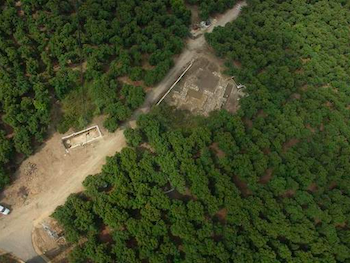
Overhead view of excavation areas at Tel Kabri
Excavations
During our initial exploratory season at Tel Kabri in 2005, our excavations were limited in nature, primarily designed to test the results of the 2003 geophysical survey concerning the size of the palace. Three different areas were excavated in order to establish the extent of the palace and to determine a field strategy for the future. These included:
Area D West: the area of the possible throne room, close to the find spot of the frescoes and the supposed northern closing wall of the palace;
Area D South: in the area of the presumed southern court of the palace;
Area D North: outside the palace, according to Kempinski's reconstruction, now lying between the avocado trees.
In Area D West, the wall which was identified by the previous excavators as the northern external wall of the MB palace was actually found to be a Byzantine terrace, below which a four-meter-thick internal wall of the palace was found. It is obvious that the palace continues to the north and west in this area.
In Area D North, we found that the plaster floors of the palace continue farther to the east, lying below the avocado trees. This indicates that the MB II palace not only continues on in this direction as well, but that — just as the geophysical survey had suggested — it is considerably larger than originally estimated by the previous excavators. It covers at least 3000-4000 sq. m., rather than 2000 sq. m., and extends farther to the north, east, and west than previously thought. We also found in this area a possible libation or olive oil processing installation. We hope to uncover more details associated with this feature when we return to the area next season.
In Areas D North and D South, destruction deposits, including restorable local pottery, burnt organic material, and imported Cypriot pottery, were discovered. In D South, there is also some evidence for metalworking, including a fragment of a crucible, some slag, small pieces of bronze sheet, and a small gold lunette.
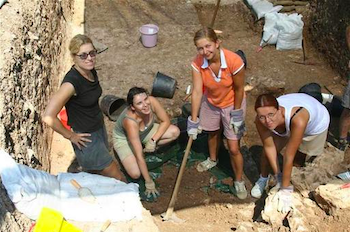
At work in area D south
During the fourth season, in 2008, limited excavations were conducted within the MB palace at Kabri, prior to beginning a full-scale campaign which is scheduled for this coming summer (see http://digkabri.wordpress.com/) and which will continue through 2012.
The 2008 excavations were designed to generate a preliminary understanding of the history of the palace, from its initial foundation to its final destruction, which was successfully achieved. We also found approximately 45 more fragments of wall plaster, at least some of which appear to be painted, as well as additional evidence for red paint on one of the plaster floors in the palace.
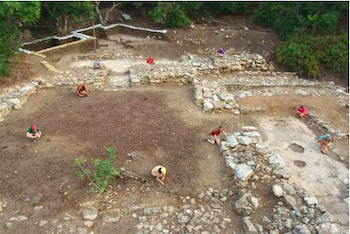
MB Palace and Ceremonial Hall 611 at the end of the 2005 season
Our excavations were concentrated in D West, the area located at the eastern edge of the MB II palace, just to the northwest of the large Ceremonial Hall 611 exposed during Kempinski and Niemeier’s earlier excavations. In order to gain insights into the stratigraphical sequence of the palace, we opened up two principal excavation areas located to the east and northwest of Ceremonial Hall 611.
The western part included Room 740, the room directly to the north of 611, as well as its long and narrow Threshold 698, in whose entrance the fragments of miniature fresco were recovered by Kempinski and Niemeier in the early 1990s. In the area to the north of Room 740, immediately on the other side of a massive, four-meter-thick wall, we excavated a substantial mudbrick and plaster collapse belonging to the final destruction of the MB II palace.
Since this collapse appeared to be separated into two parts, upper and lower, by a line of plaster, it is possible that it belonged to both the second and first floors. Embedded within this collapse, we found at least 45 fragments of high-quality wall plaster, some of which appear to have been painted, as mentioned above.
One of the fragments also seems to have a string impression on its surface, consistent with Aegean fresco-painting techniques. Since this collapse clearly continues to the north and east, beyond the limits of the 2008 excavation area, we are optimistic that we shall recover more painted wall plaster fragments in the next season when we expand out into this area.
Directly below this level of collapse, we found a thick layer of occupational debris in the form of a massive quantity of flat-lying pottery sherds stacked one on top of another and forming a stratum approximately 30 cm. in depth. The pottery, which had apparently been crushed by the collapse, consisted mainly of storage jars datable to the MB II period. Within this pottery, several fragments of imported wares were found, including a neck fragment from a Cypriot White Painted jug or juglet and two possible Aegean imports. The analysis of this pottery will allow a more accurate dating for the final destruction of the palace.
However, our 2005 and 2008 excavations also suggested that the date for the Aegean-style paintings in the palace should be reconsidered. The fragments of wall fresco were found by Kempinski and Niemeier in and next to Threshold 698, located between Hall 611 and Room 740, where they had been reused as packing material. This fill was set in place after the ashlar blocks of the threshold orthostats in Hall 611 were removed.
Niemeier suggested that the fragments of the wall fresco were used to fill the gap caused by the removal of the orthostats from Hall 611 during a “squatter phase” dating to sometime after the abandonment of the palace. However, we believe that the deposition of the fresco fragments was not the work of looters but rather was conducted during a major renovation project within the lifetime of the palace.
We discovered that the walls of Room 740, perhaps to be identified as the throne room, were considerably thickened at some point in time, effectively halving the area of the room, and no doubt changing its use. This created an unusually deep threshold, which was not paved with ashlar orthostats, unlike elsewhere in the palace, but rather was deliberately filled with the fallen fresco fragments.
During the same time, as already noted by Kempinski and others, two new walls were constructed, cutting the large room to the NE of Hall 611 into two smaller rooms and thus also altering its use. The threshold between them was, similarly to 698, also not paved with orthostats. We believe that these drastic renovations to Rooms 740, 607, and 667 are linked to a change in the use of Hall 611.
We would therefore suggest that the renovations were also made to Hall 611 during this same period of construction, resulting in the removal of the orthostats, followed by the deposition and reuse of the fresco fragments as packing material underneath Threshold 698 and within a gap left by the removal of the orthostats from the interior wall of Hall 611.
During the 2008 season, in part to test our hypothesis, we sectioned the later threshold of Room 740, as well as its floor, exposing the floor from the period preceding the extensive renovation phase. Luckily, a large deposit of pottery was found in a pit dug into this floor and which was sealed by the latest floor, thus giving a date for the renovation activity.
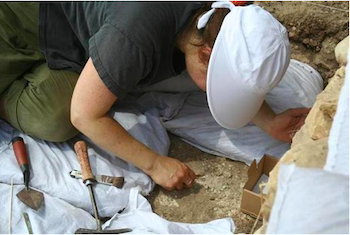
Laura D'Alessandro, Head of the Conservation Lab at the Oriental Institute at the University of Chicago, examining plaster floor in 2008
Redating the removal and the deposition of the Kabri frescoes results in a new, and earlier, relative chronology for the frescoes at Tel Kabri. Although much additional work is needed to pinpoint the absolute chronology of the Kabri frescoes, our suggested redating would make them considerably earlier than the Tel el-Dab'a Thutmoside frescoes and perhaps nearly contemporary with the Akrotiri frescoes on Santorini, which these at Kabri so closely resemble.
Turning now to the eastern part of D West, we initiated excavations in this area in 2008 in an effort to investigate the earlier phases of the palace. Here we descended underneath Room 703, dating to the latest phase of the palace, for the floor of this room had already been cut by Kempinski. We were able to successfully reconstruct the entire occupational history of the palace, which is as follows.
Prior to the construction of the palace, the area was very likely occupied by domestic structures, complete with intramural burials, datable to the middle part of the MB I period. Contacts with Cyprus were already taking place in this early phase, as indicated by sherds of Cypriot Red on Black pottery. These contacts with Cyprus then continued throughout the history of the palace.
The massive foundations of Wall 733 indicate that the earliest palace was of an astonishingly solid construction, reminiscent of the MB fortifications for the entire tel. The solid construction of this wall, using stones which were much larger than those used in the later phases of the palace, confirms Kempinski’s hypothesis that a large earlier structure lay below the MB II palace. However, rather than calling this earlier structure a “public building” or a “proto-palace” as Kempinski did, we would now suggest that it is in fact simply an earlier phase of the palace itself. The transition from MB I to MB II at Tel Kabri was not marked by the building of a palace, as Kempinski thought, but rather by modifications to a palace which already existed, having been built during MB I.
In fact, the palace seems to have existed for as many as 250 years and underwent a series of renovations during its lifetime, including modifications in internal plan, mending of floors, and changes in the functions of rooms. We can already write the history of individual rooms and can date the overall history of the palace from its inception in MB I to its destruction in MB II. However, a general internal phasing of the palace will have to wait until additional excavations have been conducted, further exposing the history of each specific room and area.
The zooarchaeological finds from this area were exceptionally rich and will enable us to detect differences in culinary practices between the pre-palatial structures and the various phases of the palace. A drain blocked during the early phase of the palace yielded a very well preserved assemblage of bones, which includes the bones of bovines, equids, sheep, and goats, as well as the pinchers of crabs. These may be remains of feasting connected with the latest use of the early palace phase.
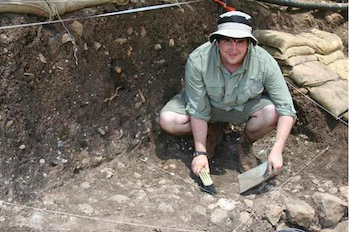
Alex Cleveland displays his handiwork
Conclusions
In conclusion, the first four years of the Tel Kabri archaeological project have shown the considerable scientific potential of long-term exploration at the site. Already, the combination of the regional study and the excavation of the palace has resulted in a new view of the development of power in the area during the Middle Bronze Age.
Rather than a slow evolution, we see a swift transition from a non-urban settlement pattern to a well-formed polity, with a fortified urban center in its midst. The MB II palace of Kabri did not arise from a patrician house or from a “proto-palace,” but rather evolved from a previously existing and monumental MB I structure with formidable walls made of near-cyclopean masonry. This fine tuning of our understanding of the phases of the palace has also opened up new possibilities for the interpretation of the chronology of the Aegean-style paintings within the MB II palace.
Finally, the possible Aegean pottery sherds which we have discovered and which come from both the latest occupational deposits as well as earlier contexts at Tel Kabri may also suggest, if proven to actually originate in the Aegean, that the interactions between the Aegean area and the palatial elite of Tel Kabri lasted throughout the history of the palace and included not only the commissioning of Aegean-style art but also the importation of high-quality ceramics and possibly other objects as well.
Future Plans
We expect to learn more about the palace in particular and the site as a whole when we return for our next season of excavations this coming summer from June 21st to July 30th, 2009. We welcome inquiries from anyone interested in serving as a staff member or volunteer. Those interested should first consult our website (http://digkabri.wordpress.com/).
1 A. Yasur-Landau, E.H. Cline, and G.A. Pierce, “Middle Bronze Age Settlement Patterns in the Western Galilee, Israel,” Journal of Field Archaeology 33/1 (2008) 59-83.
2 E.H. Cline and A. Yasur-Landau, “Poetry in Motion: Canaanite Rulership and Aegean Narrative at Kabri,” in EPOS: Reconsidering Greek Epic and Aegean Bronze Age Archaeology: 157-165, S.P. Morris and R. Laffineur, eds. Aegaeum 28. Liège: Université de Liège. 2007.
If our reconstruction is correct, the original painted floor and the wall fresco do not simply belong to the phase after the renovation of the palace, as Niemeier and Kempinski suggested, but date instead to a phase before the renovation. We tentatively suggest that the “use” period of the frescoes, i.e., the time when the frescoes were actually attached to the wall and served to decorate the interior of the palace, was during the pre-renovation phase of the palace, which is dated to the middle part of the MB II period. We believe that it was during the actual renovation that the wall fresco was torn down and reused as packing material under Threshold 698 and elsewhere.
We have already published some of the more noteworthy accomplishments in the EPOS conference volume which appeared in 2007,2 including further discussions of the data just presented.
